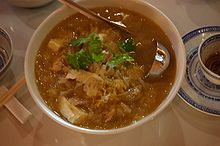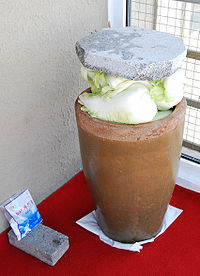- Suan cai
-
Suan cai 
Suan Cai stewed with pork and cellophane noodle is a very common dish in Northeastern China Chinese 酸菜 Hanyu Pinyin suān cài Literal meaning sour vegetable Transcriptions Mandarin - Hanyu Pinyin suān cài Cantonese (Yue) - Jyutping syun1 coi3 Alternative Chinese name Chinese 鹹菜 Literal meaning salted vegetable Transcriptions Min - Hokkien POJ kiâm-chhài Suan cai (also called Chinese sauerkraut), or in English, "sour vegetable", is a traditional Chinese pickled Chinese cabbage. It is used in a variety of ways. Suan cai is a unique form of pao cai, due to the material used and the method of production.
Contents
Production
Traditionally, Northern China has used Napa cabbage as the vegetable of choice while Southern China uses the Chinese mustard "jìe cai" (芥菜) variety to make suan cai (Cant. syun choy). Suan cai differs from the rest of pao cai in the production process in that the vegetable is compressed. This is accomplished by placing a heavy weight such as a large rock on top of the cover of the container so that the Chinese cabbage inside the container is slowly pressed and fermented. The processing of the vegetable helps to create a distinct flavor.
Generally, the cabbage is dipped into boiling water, then put in a container with cold water with salt. Suan cai is often used in cooking with meat, especially pork. It is said to neutralize the grease of meat.
Regional
Mainland China and Taiwan
In Chinese Islamic cuisine, suan cai can top off noodle soups, especially beef noodle soup.
Hunan
In Hunan, suan cai is frequently made with ginger and chilies (typical of Hunan cuisine).
Guangdong and Hong Kong
In Cantonese cuisine, it is served in a small dish often as an appetiser. They are usually free. Sometimes it can be available in mini-containers on the dining table. There are also Cantonese variations such as salted suan cai (鹹酸菜).
Northeast China
In Northeastern Chinese cuisine, suan cai are made from napa cabbage or head cabbage and has a similar taste with saurkraut. As part of the cuisine in Manchuria, it is used with dumplings and boiled, or stir fried, and more frequently, it is used to make suan cai and pork stew.
Hot pot
In hot pot cuisine, it has been used as one of the ingredients.
Comparison
Suan cai is similar to a fermented-cabbage dish, sauerkraut, which is common in many northern European cuisines, especially German cuisine.
In popular culture
A popular sitcom and namesake song depicting lives in Northeast China Cui Hua Shang Suan Cai (翠花,上酸菜, literally "Cui Hua, serve the suan cai") debuted in 2001, and the phrase Cui Hua Shang Suan Cai became a popular catch phrase. Suan cai became synonymous with a person from Northeast China. A company in China registered "Cui Hua" brand packaged suan cai.[1]
See also
References
External links
- A common type of jiecai 芥菜 that is used to make suancai
- A photo series of the process after salting
- A photo series containing jiecai harvest and suaicai production
- Suancai sold in a tub in Hongkong
Northeastern Chinese cuisine Chinese pickles Categories:
Wikimedia Foundation. 2010.

